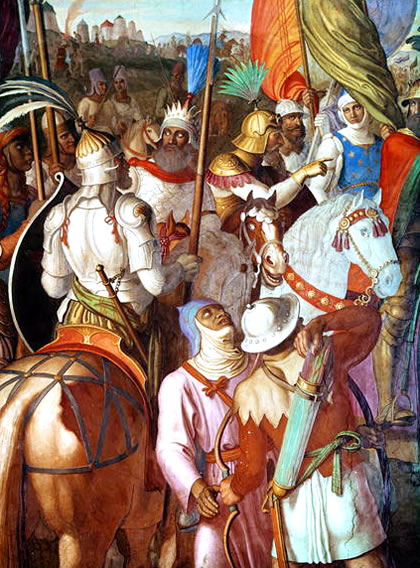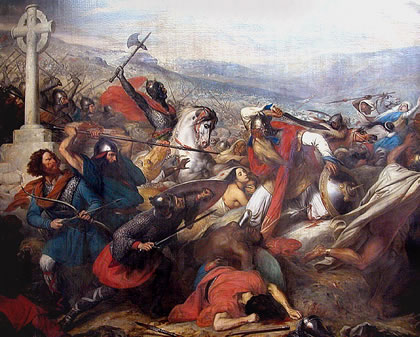 |
| French Army |
The first wave of Muslim expansion into Iberia, present-day Spain and Portugal, began in 711 during the reign of the Umayyad caliph Abd al-Malik. Led by a Berber commander, Tariq ibn al-Ziyad, this expedition landed in Gibraltar and was followed by further Muslim expansion and the foundation of an Umayyad dominion in Iberia, centered in the city of Córdoba.
The Muslims were able to overcome the small states that existed in Iberia because of the fractured nature of Iberian Christendom. In 730 the Umayyad caliph Hisham ibn Abd al-Malik appointed a new governor, Abd al-Rahman al-Ghafiqi, of the Iberian Muslim state, known in Arabic as al-Andalus.
Despite their religious differences, some Muslim and Christian rulers signed treaties with one another and formed alliances in order to further their political goals.
In 721 the army of Eudes, Christian duke of Aquitaine, defeated an Umayyad invasion force at Toulouse. However Muslim incursions into France continued, reaching as far north as the province of Burgundy by the mid-720s.
Eudes formed an alliance with Uthman ibn Naissa, the Berber ruler of Catalonia, and when Uthman rebelled against Abd al-Rahman, he was dragged into a conflict with the Umayyads. After defeating Uthman’s forces, Abd al-Rahman began to campaign against Eudes, defeating him in a fierce battle near the city of Bordeaux and the Garonne River.
Desperate for aid, Eudes turned toward the Carolingian Frankish ruler Charles Martel, agreeing to submit to his authority. Charles, son of Pippin the Middle and mayor of the Palace and ruler of the Frankish realms of Austrasia, moved his infantry army south to intercept Abd al-Rahman and tens of thousands of Muslim cavalrymen heading toward the monastery of St. Martin in Tours.
In October 732 Charles positioned the Frankish army, which was made up entirely of armored infantrymen equipped with heavy shields and long spears, between the Muslim invasion force and the monastery of St. Martin.
Abd al-Rahman’s army, which was made up entirely of Arab and Berber cavalry, met the Franks near Tours and the two sides scouted one another’s positions and skirmished for nearly a week before commencing battle on the seventh day. Abd al-Rahman’s army was the larger of the two.
 |
| Abd al-Rahman killed in the battle |
The Frankish infantry formed into a tightly grouped phalanx and managed to repel successive Muslim cavalry charges throughout the day. Late in the battle Abd al-Rahman was killed while trying to rally waning Muslim forces and his army halted their attacks.
With a substantial amount of captured treasure from their campaign in southern France, the Muslims decided to withdraw south back toward Iberia. In later campaigns, Charles continued to push the Iberian Muslims back across the Pyrenees Mountains and out of France.
Scholars, including the 18th century English historian Edward Gibbon, saw Charles’s victory as a landmark moment in history when a Christian ruler halted Muslim forces from advancing farther into western Europe and establishing an Islamic state there.
Because of his defeat of a much larger Muslim force, Charles was given the nickname Martel or “The Hammer” and continued to expand Carolingian power throughout France and Germany. His grandson Charlemagne would rule over a Frankish empire as one of the most powerful Christian rulers in Europe.
EmoticonEmoticon